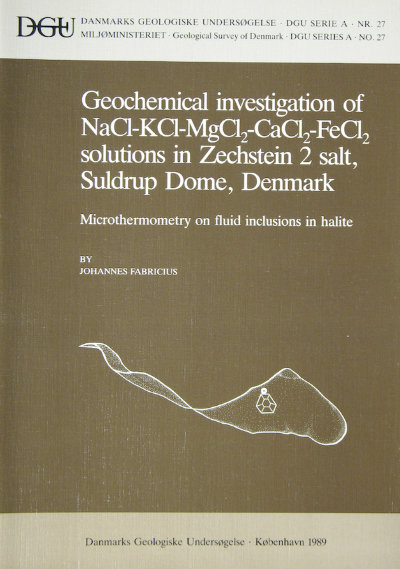Geochemical investigation of NaCl-KCl-MgCl2-CaCl2-FeCl2 solutions in Zechstein 2 salt, Suldrup Dome, Denmark. Microthermometry on fluid inclusions in halite
DOI:
https://doi.org/10.34194/seriea.v27.7047Keywords:
Fluid inclusions, halite, bischofite, P-T conditions, salt domesAbstract
Large, irregular fluid inclusions with daughter bischofite, MgCl2 • 6H2O, in recrystallized halite from former brine pockets in grey Zechstein 2 rock salt from the Suldrup dome, Denmark, were studied by means of microthermometry. The test material consists of ca 3 kg cleavage pieces and a piece of core of extremely clean, colourles, limpid halite. Anhydrite and pyrrhotite are present as solid inclusions in trace amounts only. The irregular inclusions studied all contain daughter bischofite at room temperature. Optical, crystallographic, and chemical (melting) methods proved the daughter mineral to be bischofite. The mean dissolving temperature Tmhex = 56.5 ± 0.9°C, 95% confidence limit, of 117 measurements yields, from pertinent phase diagrams, a quantitative composition of the equilibrium solution: 114 mol MgCl2 + 1.2 mol K2Cl2 per 1000 mol H2O, saturated with NaCl (ca. 2 mol Na2Cl2 per 100 mol H2O). Exposed to the atmosphere, the equilibrium solution becomes orange yellowish after some days, thus proving the presence of FeCl2 (5-10 mol/1000 mol H2O). In one inclusion carnallite (KMgCl3 • 6H2O) was observed, the dissolving temperature Tmcar = 81.9°C of which is a minimum trapping temperature. The minimum trapping pressure is calculated at slightly higher than 65 MPa. The viscosity at 80°C is estimated at ca. 4 centipoise. Measurements of the homogenization temperature in fluid phase are meaningless due to the presence of compressed gas, possibly H2S. The following model is proposed concerning the formation of the studied halite: During the end of the diapiric penetration phase in Lower Cretaceous, a metamorphic lye mixed with concentrated sea water in NaCl facies in brine pockets within the grey Zechstein 2 rock salt, causing salting out of the studied halite. The metamorphic lye derived from a metamorphosed carnallitic potash zone. The carnallitic solution was mixed with an infiltrating rinneitic (3KC1 · NaCl · FeCl2) solution. The mixture was squeezed out from the potash zone during the diapiric penetration phase, leaving a trail of disseminated grains and fracture fillings of carnallite all the way up to the former brine pockets. The minerals bischofite and pyrrhotite, Fe1-xS, are reported from Denmark for the first time.
Downloads
Published
Issue
Section
License
This article is distributed under a CC-BY 4.0 licence, permitting free redistribution and reproduction for any purpose, even commercial, provided proper citation of the original work. Author(s) retain copyright over the article contents.


